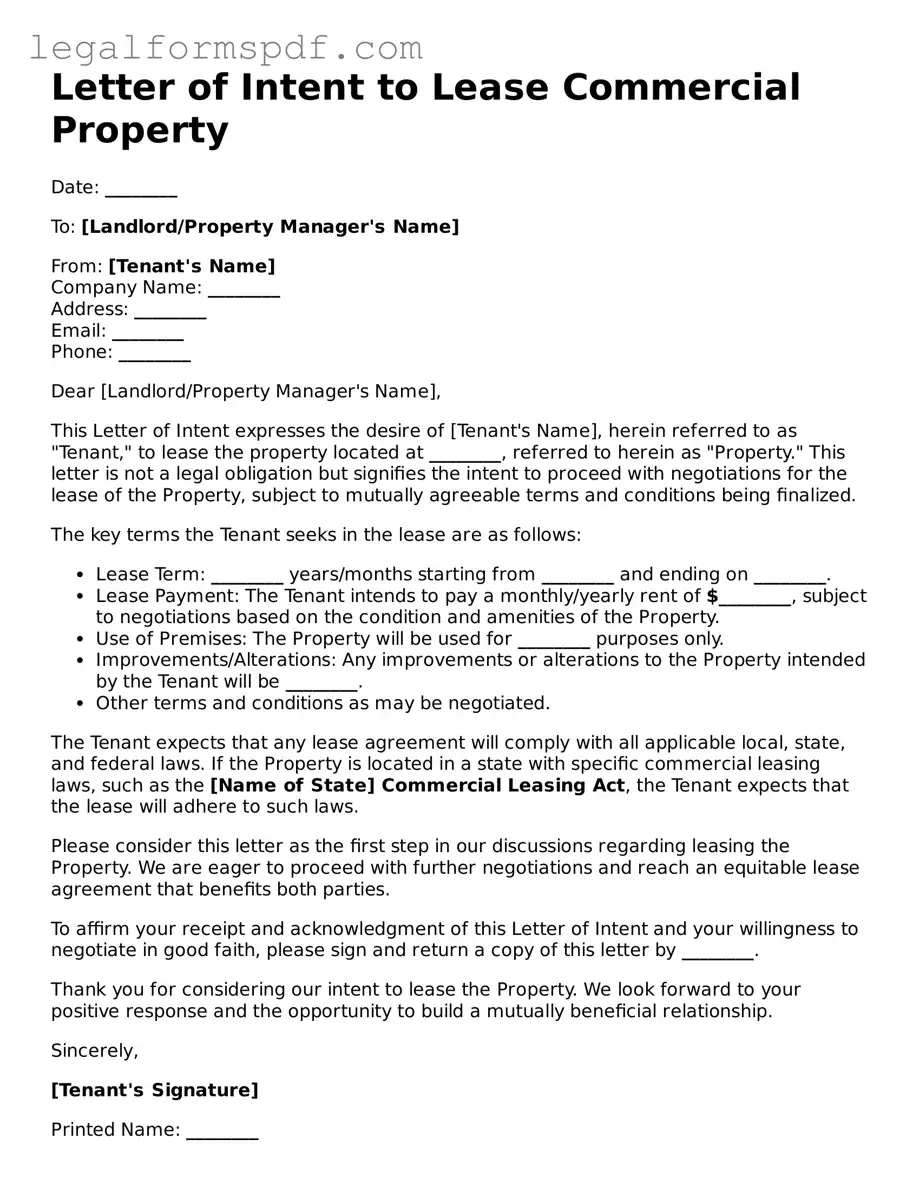The Letter of Intent to Lease Commercial Property is similar to a Residential Lease Agreement, which outlines the terms and conditions under which a residential property is leased. Both documents serve as preliminary agreements before a more detailed contract is drafted, establishing the fundamental terms like rent, duration, and the responsibilities of each party. However, the former focuses on commercial properties and might include terms related to commercial activities that are not present in residential agreements.
Comparable to a Commercial Lease Agreement, this document lays the groundwork for leasing terms specific to business properties. While a Letter of Intent is more of a proposal indicating a party's interest in entering a lease and setting the stage for negotiations, a Commercial Lease Agreement is a binding contract that specifies the detailed terms and conditions under which a tenant can use the commercial space. Both are crucial in the leasing process of commercial properties, albeit at different stages.
Similar in nature to a Real Estate Purchase Agreement, which details the terms of a property sale, the Letter of Intent for leasing shares the initial intention to enter into a formal agreement. Both documents are preliminary steps in their respective transactions, providing a framework that outlines key terms such as price for purchases, or lease term and rent for leases, yet neither constitutes a final, binding contract upon their execution.
A Memorandum of Understanding (MOU) also resembles the Letter of Intent to Lease Commercial Property. An MOU outlines the preliminary understanding between parties intending to work together on a project or within a partnership. While it is broader in scope and not limited to real estate, like the Letter of Intent, it serves as a non-binding agreement that precedes a more formal contract, documenting the parties' intentions and key terms agreed upon in principle.
The Letter of Intent to Lease Commercial Property shares similarities with a Commercial Sublease Agreement in that both involve the leasing of commercial property. However, a Sublease Agreement is used when an original tenant wants to rent out their leased premises to a new tenant. Both documents outline terms such as rent and lease duration, but the Letter of Intent precedes a primary lease agreement, while a Sublease Agreement operates under the terms of an existing lease.
A Property Management Agreement, while fundamentally different, shares the premise of detailing terms related to the use of property. This agreement is between a property owner and a management company or individual, specifying duties such as maintenance, tenant screening, and rent collection. The Letter of Intent to Lease, in contrast, sets the stage for an agreement between the property owner and potential tenant but similarly indicates an intention to enter a formal arrangement regarding the property's use.
Similar to an Option to Lease Agreement, which grants one party the exclusive right to lease property within a specified period, a Letter of Intent signifies the preliminary steps toward securing a lease. Both documents highlight the parties' initial agreement on key leasing terms before committing to a binding contract. However, the Option to Lease Agreement typically requires an upfront payment for the exclusive right, distinguishing it from the primarily non-financial Letter of Intent.
The Letter of Intent to Lease Commercial Property is akin to a Business Plan Proposal in that both are preparatory documents outlining proposed terms or actions. While a Business Plan Proposal lays out a company's strategy and objectives for achieving success, a Letter of Intent outlines the intentions of leasing a commercial space beneficial to the business's operation. Both serve as initial steps towards a larger goal, be it securing investment or leasing premises.
A Partnership Agreement, though primarily focused on the relationship between business partners and their obligations to each other, similarly precedes more significant commitments. Like the Letter of Intent, a Partnership Agreement might detail the preliminary understanding regarding the use of commercial property as part of the partners' business operations. Despite their different focuses, both documents are crucial for laying the groundwork for future operations and agreements.
Lastly, the Letter of Intent to Lease Commercial Property parallels a Tenant Improvement Allowance Letter, which is often part of lease negotiations, detailing funds provided by the landlord for improvements. Both documents are key in the early stages of a lease agreement, setting expectations and terms. However, the Tenant Improvement Allowance Letter specifically addresses the financial aspect of property modifications, while the Letter of Intent broadly covers intentions to lease and general terms.
